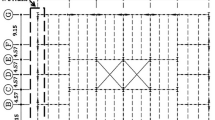Abstract
The primary stage in introducing significant uncertainties into the performance-based earthquake engineering technique of the next generation is the development of fragility curves. The technique of representing epistemic and aleatory uncertainties for moment-resisting steel frames is proposed in this manuscript. Incremental dynamic analysis (IDA) utilizes for considering aleatory uncertainty and epistemic uncertainty is taken into account through mass, damping, yielding stress, and a module of elasticity that is provided in four limit states of damage. The optimized fuzzy approach is applied to address this. Epistemic and aleatory uncertainties have been included in the 3D-fragility curves; epistemic’ input is fuzzy values, and fragility curves’ standard deviation and mean are estimated by using the optimized fuzzy approach, which is used PSO algorithm. The IDA approach is used to create scenarios that are used to train the FCMPSO algorithm. Verification was done by applying the Monte Carlo procedure results. The approach that has been used here is beneficial regarding to both accuracy and execution time in driving the 3D-fragility curves.
















Similar content being viewed by others
References
Jough, F. K. G.; Veghar, M.; Beheshti-Aval, S. B.: Epistemic uncertainty treatment using group method of data handling algorithm in seismic collapse fragility. Latin Am J Solids Struct, 18 (2021)
Jough, F.K.G.; Şensoy, S.: Prediction of seismic collapse risk of steel moment frame mid-rise structures by meta-heuristic algorithms. Earthq. Eng. Eng. Vib. 15(4), 743–757 (2016)
Rahnama, M.; Krawinkler, H.: Effects of Soft Soil and Hysteresis Model on Seismic Demands. No. 108.John A. Blume Earthquake Engineering Center, Stanford (1993)
Sivaselvan, M.V.; Reinhorn, A.M.: Collapse analysis: Large inelastic deformations analysis of planar frames. J. Struct. Eng. 128(12), 1575–1583 (2002)
Ibarra, L.F.; Krawinkler, H.: Global Collapse of Frame Structures Under Seismic Excitations. Pacific Earthquake Engineering Research Center, Berkeley (2005)
Burgan, H.I.: Numerical modeling of structural irregularities on unsymmetrical buildings. Tehnički vjesnik 28(3), 856–861 (2021)
Wu, J.R.; Di Sarno, L.: A machine-learning method for deriving state-dependent fragility curves of existing steel moment frames with masonry infills. Eng. Struct. 276, 115345 (2023)
Morfidis, K.; Kostinakis, K.: Seismic parameters’ combinations for the optimum prediction of the damage state of R/C buildings using neural networks. Adv. Eng. Softw. 106, 1–6 (2017)
Moradi, S.; Burton, H.V.: Response surface analysis and optimization of controlled rocking steel braced frames. Bull. Earthq. Eng. 16(10), 4861–4892 (2018)
Zhang, Y.; Burton, H.V.; Sun, H.; Shokrabadi, M.: A machine learning framework for assessing post-earthquake structural safety. Struct. Saf. 72, 1–6 (2018)
Kiani, J.; Camp, C.; Pezeshk, S.: On the application of machine learning techniques to derive seismic fragility curves. Comput. Struct. 218, 108–122 (2019)
Kennedy, J.: ‘Particle Swarm Optimization. Encyclopaedia of Machine Learning, p. 760–766. Springer, Berlin (2010)
Jough, F.K.G.; Aval, S.B.: Uncertainty analysis through development of seismic fragility curve for an SMRF structure using an adaptive neuro-fuzzy inference system based on fuzzy C-means algorithm. Sci. Iran. 25(6), 2938–2953 (2018)
Yang, F.; Sun, T.;, Zhang, C.: An efficient hybrid data clustering method based on K-harmonic means and particle swarm optimization. Expert Syst. Appl. (2009)
Mitropoulou, C.C.; Papadrakakis, M.: Developing fragility curves based on neural network IDA predictions. Eng. Struct. 33(12), 3409–3421 (2011)
Vamvatsikos, D.; Cornell, C.A.: Incremental dynamic analysis. Earthquake Eng. Struct. Dynam. 31(3), 491–514 (2002)
Ellingwood, B.: Quantifying and communicating uncertainty in seismic risk assessment. Struct. Saf. 31, 179–187 (2009)
Rubinstein, R.Y.: Simulation and The Monte Carlo Method. Wiley, New York (1981)
Pinto, P.; Giannini, R.; Franchin, P.: Seismic Reliability Analysis of Structures. IUSS Press, Pavia (2005)
HAZUS-MH MR1 2003. Advance engineering building module. Report by: Department of homeland security emergency preparedness and Response Directorate, FEMA Mitigation Division Washington, D.C., U.S.A
Seo, J.; Linzell, D.G.: Use of response surface metamodels to generate system level fragilities for existing curved steel bridges. Eng. Struct. 52, 642–653 (2013)
Beer, M.: Fuzzy probability theory. Encycl. Complex. Syst. Sci. 6, 4047–4059 (2009)
Standard No. 2800: Iranian Code of Practice for Seismic Resistant Design of Buildings, Building and Housing Research Center, 3rd Edition, Iran (2007)
Charney, F. A.; Downs, W. M. (2004). Modeling procedures for panel zone deformations in moment resisting frames. In: Proceedings of the Coference Connections in Steel Structures V, Amsterdam, pp. 121–130
Foutch, D.A.; Yun, S.Y.: Modeling of steel moment frames for seismic loads. J. Constr. Steel Res. 58(5–8), 529–564 (2002)
Cardoso, J.B.; de Almeida, J.R.; Dias, J.M.; Coelho, P.G.: Structural reliability analysis using Monte Carlo simulation and neural networks. Adv. Eng. Softw. 39(6), 505–513 (2008)
Porter, K.A.; Beck, J.L.; Shaikhutdinov, R.V.: Sensitivity of building loss estimates to major uncertain variables. Earthq. Spectra 18(4), 719–743 (2002)
Liel, A. B.; Haselton, C. B.; Deierlein, G. G.; Baker, J. W.: Incorporating modeling uncertainties in the assessment of seismic collapse risk of buildings. Struct. Saf., pp. 197–211 (2009)
Author information
Authors and Affiliations
Corresponding author
Rights and permissions
Springer Nature or its licensor (e.g. a society or other partner) holds exclusive rights to this article under a publishing agreement with the author(s) or other rightsholder(s); author self-archiving of the accepted manuscript version of this article is solely governed by the terms of such publishing agreement and applicable law.
About this article
Cite this article
Karimi Ghaleh Jough, F., Ghasemzadeh, B. Uncertainty Interval Analysis of Steel Moment Frame by Development of 3D-Fragility Curves Towards Optimized Fuzzy Method. Arab J Sci Eng 49, 4813–4830 (2024). https://doi.org/10.1007/s13369-023-08223-8
Received:
Accepted:
Published:
Issue Date:
DOI: https://doi.org/10.1007/s13369-023-08223-8




